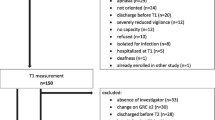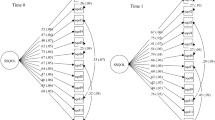Abstract
Background and Purpose: The impact of stroke is multidimensional however standard stroke measures do not discriminate well when stroke patients are less physically impaired. The Stroke Impact Scale 2.0 (SIS 2.0) is a multidimensional measure of the impact of stroke but its' psychometric properties require further testing. The SIS-16 is a measure of physical functioning designed to be more sensitive to differences in physical functioning than current stroke outcome measures but there is only preliminary information detailing its' reliability and validity. The current study examined the internal consistency and validity of the SIS 2.0 and SIS-16 in an Australian sample of stroke patients. Methods: The SIS 2.0, SIS-16, World Health Organization Bref-Scale (WHOQOL-BREF) and Zung's Self-Rating Depression Scale (SDS) were completed by 74 stroke patients in rural Victoria, Australia. Results: The item convergent validity index indicated good item convergence of the SIS-16 and SIS 2.0 domains. The item discriminant validity index had only adequate divergence for most SIS 2.0 domains. Internal consistencies of the SIS-16 and SIS 2.0 domains were acceptable (α = 0.87–0.95). Correlations between the SIS-16 and SIS 2.0 and the WHOQOL-BREF and SDS supported the convergent and discriminant validity of the SIS-16 and all the dimensions of the SIS 2.0 except 'Participation' which lacked discriminant validity. Conclusions: The SIS 2.0 and SIS-16 had good psychometric properties with support for the internal consistency and validity of both measures.
Similar content being viewed by others
References
Pound P, Gompertz P, Ebrahim S. A patient-centered study of the consequences of stroke. Clinical Rehabil 1998; 12: 338–347.
Duncan PW, Lai SM, Bode RK, Perea S, DeRosa JT, GAIN Americas Investigators. Development of the SIS-16 and comparison with the Barthel Index. Neurology (under review).
Bowling A. Measuring Health: A Review of Quality of Life Measurement Scales. Open University Press, Buckingham, Philadelphia. 1997.
Duncan PW, Wallace D, Lai SM, Johnson D, Embretson S, Laster LJ. The Stroke Impact Scale Version 2.0. Evaluation of reliability, validity, and sensitivity to change. Stroke 1999; 30: 2131–2140.
Petersen C, Morfeld M, Bullinger, M. Testing and validation of the German version of the Stroke Impact Scale. Fortschritte der Neurologie Psychiatrie 2001; 69(6): 284–290.
Wright BD, Masters GN. Rating Scale Analysis: Rasch Measurement. Chicago: MESA Press, 1982.
O'Connell B, Hanna B, Penney W, Pearce J, Owen M, Warelow P. Stroke Survivors' Health Care Needs in Regional and Rural Settings. Geelong, Australia: Deakin University, 2001.
The WHOQOL Group. Development of the World Health Organization WHOQOL-BREF quality of life assessment. Psychol Med 1998; 28: 551–558.
Zung WW. A self-rating depression scale. Arch Gen Psychiatry 1965; 12: 63–70.
Clarke P, Black S, Badley E, Lawrence J, Williams J. Handicap in stroke survivors. Disability Rehabilitation 1999; 21: 116–123.
The WHOQOL group. The World Health Organization Quality of Life (WHOQOL). Development and general psychometric properties. Social Science 1998; 46: 1569–1585.
World Health Organisation. (1999) Annotated Bibliography of the WHO Quality of Life Assessment Instrument. WHO: Geneva.
Gabrys JB, Peters K. Reliability, discriminant and predictive validity of the Zung Self-rating Depression Scale. Psychological Rep 1985; 57: 1091–1096.
de-Jonghe JF, Baneke JJ. The Zung Self-Rating Depression Scale: A replication study on reliability, validity and prediction. Psychological Rep 1989; 64: 833–834.
Stuart, AL, Ware JE. Measuring Functioning and Well-Being the Medical Outcomes Study Approach. Durham, North Carolina: Duke University Press, 1992, 375–376.
Ware JE, Gandek B. Methods for testing data quality, scaling assumptions, and reliability: The IQOLA project approach. J Clin Epidemiol 1998; 51: 945–952.
Apolone G, Filiberti A, Cifani S, Ruggiata R, Mosconi P. Evaluation of the EORTC QLQ-C30 questionnaire: A comparison with SF-36 Health Survey in a cohort of Italian long-survival cancer patients. Ann Oncol 1998; 9: 549–557.
Campbell DT, Fiske DW. Convergent and discriminant validation by the multitrait-multimethod matrix. Psychol Bull 1959; 56: 81–105.
Howell DC. Statistical Methods for Psychology. 1982. Boston, Massachusetts: Duxbury Press.
Kvien TK, Kaasa S, Smedstad LM. Performance of the Norweigen SF-36 health survey in patients with rheumatoid arthritis. II. A comparison of the SF-36 with disease-specific measures. J Clin Epidemiol 1998; 51: 953–959.
Nunnally J. Psychometric Theory. New York: McGaw-Hill, 1978.
Author information
Authors and Affiliations
Rights and permissions
About this article
Cite this article
Edwards, B., O'Connell, B. Internal consistency and validity of the Stroke Impact Scale 2.0 (SIS 2.0) and SIS-16 in an Australian sample. Qual Life Res 12, 1127–1135 (2003). https://doi.org/10.1023/A:1026109920478
Issue Date:
DOI: https://doi.org/10.1023/A:1026109920478




